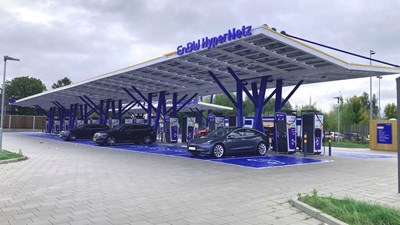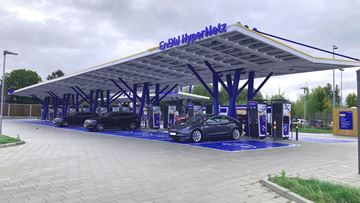'It starts by following Athlon's five-step mobility plan'
If you're trying to reach Alexander Heijkamp in his office in the Netherlands, there's a pretty good chance you'll be talking to his answering machine instead. Alexander is often on the road – crisscrossing between Paris, Belgium, Rome, Madrid and the Netherlands in the span of a fortnight is nothing unusual in his busy schedule. In fact, that's exactly how he spent the last two weeks of September this year.
We managed to catch him in-between travels to ask him how he organized these business trips, in order to keep his carbon footprint as low as possible. "It all starts by following Athlon's five-step mobility plan," Alexander explains.
Step 1: Do you really need to travel?
Before you hit the road, tracks or skies on the way to your next meeting, ask yourself if it's really necessary to go out at all. Many meetings can easily be turned into a video conference or a couple of e-mails or chat messages – saving you not only carbon emissions, but also time and money.
Alexander: "I kicked off the week with an appointment in Paris. After considering meeting my colleagues online, I realized that the complex topics on the agenda were better discussed in person. So, traveling was necessary, but to keep my footprint low I decided to schedule multiple appointments in Paris. That way, I could efficiently cross off more than one meeting on my to-do list and I wouldn't have to travel just for that one occasion."

Step 2: Choose the best mode of transportation
Which mode of transport will you use to arrive at your destination? Whatever the options are for your specific trip, always consider more sustainable alternatives before automatically hopping on the next plane there. For distances up to 750 kilometers that should be doable with a little planning ahead.
Why not take the train? That's also how Alexander eventually made it to Paris. "I had some work I wanted to finish, which made the international high-speed train the perfect mobility choice for this trip. I could type away in my comfortable seat, without having to keep my eyes on the road or get frustrated by traffic. And I got to Paris fast: the door-to-door travel time was only four hours."
Train trumps plane
Traveling by plane will usually get you to your destination faster, but is it really worth all the hustle and bustle – not to mention the inherent damage to the environment? Not always. Alexander did the math for another business trip to Rome, where he would be keynote speaker at a customer event – a job best done in person:
"Again, I arranged multiple meetings in Italy to get the most out of my trip. Later, I packed my things and left for Utrecht Central Station at 9 PM, where the night train took me to the buzzing city center of Rome by 2 PM the next day. Total traveling time: about 17 hours, but I slept peacefully for most of it.
"I made good use of the remainder of the journey, by working while traveling and deep-diving into some difficult reads I kept putting off because I always lacked the time for it. I also allowed myself to relax and enjoy the ride. This way, the trip enabled me to arrive at my destination feeling refreshed and ready to take on my busy schedule."
"Alternatively, if I had taken the plane, I would have had to wake up in the middle of the night – which I hate, by the way – to get ready and leave for Schiphol airport at 6 AM. Only to take off at 9.30 AM and arrive in Rome around noon, feeling exhausted and on edge after all the airport formalities. Total traveling time: about 6 hours, but I would have only saved the six hours’ worth of time that I ended up sleeping on the train. Also worth mentioning; I avoided 224 kilograms of CO2 emissions by choosing to travel by train instead of plane."
What if you have a really long road ahead, a very tight time schedule or the train is not really an option? Read on – in step 5 we’ll explain how to make your travel (a little bit) more sustainable.
Step 3: If driving is your best option, go electric
Driving might be your best option, especially if you don't have last-minute tasks on your plate, your appointment doesn't match train schedules or its location isn't accessible by public transportIn that case, go for the most sustainable vehicle available: driving an electric car means zero tailpipe CO₂ emissions – and that's good news for our environment.
Alexander has been a big fan of electric driving for years, so he was happy to take his EV to drive to Belgium: "After the meetings in Paris I was expected to give a keynote speech at an event in Belgium, just a few hundred kilometres from my home in the Netherlands. The location was quite remote, with no easy train connection available, and I had to be there early, so I decided to drive my electric car. No tedious task at all for me, as driving electric is by far my preferred mode of transport."

Project Zero
It was just last year that Alexander took on the challenge of driving 12,000 kilometers across Europe with his full-electric Mercedes EQA. During his inspiring road trip, he spoke with a lot of interesting people about the future of mobility. Discover the insights raised during Project Zero.
Step 4: Stay safe and healthy
Whichever mobility option you choose for your long-distance travels, always be careful and put your health and safety first. Of course, you have the most control over your own safety when you're driving, as you're the one behind the wheel.
Alexander's tip: Use digital tools to help increase your safety on the road. Athlon SafeDrivePod, for example, is a nifty tiny device that blocks smartphone apps (except for navigation apps) when driving, and thus eliminates distractions. Brightmile is an interesting option too: the app keeps track of your driving behavior and gives personalized directions on how to improve it.
Step 5: Compensate your CO2 emissions
For destinations that are over 750 kilometers away, or when you simply cannot squeeze the scenic route into your tight schedule, traveling by plane might just be your only option. For example when Alexander had to travel from Rome to Madrid: Due to the challenge in time and also practically looking at connections, the plane was the best option for this specific trip. “But to also make this mode of travel sustainable, you can compensate your CO2 emissions. Just like I did with this trip by plane from Rome to Madrid and later that week from Madrid to Amsterdam.”

Alexander: "Flying is sometimes the best means to fulfill your mobility needs, especially when you work in an international organization. And that’s still okay. But what really needs to change, is people clinging on to their ingrained travel habits and choosing mobility options on autopilot – in both professional and personal contexts. Dare to shake things up and try to do it differently: Give yourself a break from the constant rat race and, above all, give our environment a break..."
“Dare to shake things up and try to do it differently: to give yourself a break from the constant rat race and, above all, to give our environment a break.”
Alexander's tip: three ways to compensate your CO2 emissions
Donate money
Donate money to charity, climate protection projects that reduce CO2 emissions or projects that improve working conditions at home or abroad, or plant trees in a forest.
Check your travel organization
Check if your travel organization includes CO2 compensation in their offer
Focus on recycling
Focus on recycling and reusing products as much as possible and switch to clean energy
The vital role of your company travel policy
Organizations as a whole, and their fleet and HR managers in particular, can play a huge part in supporting their employees to make the most sustainable and safe choices for long-distance business trips. How? By defining the company's vision on sustainable and safe travel, recording clear guidelines in a corporate travel policy, and offering the right tools and assistance individual employees need.
Note to fleet managers and HR teams: define your company's vision on sustainable and safe travel, record clear guidelines in a corporate travel policy, and offer just the right tools and assistance individual employees need.
Athlon's five-step mobility plan offers you the perfect framework for making sustainable mobility choices. Want to know more about how you can make it work in your company?


